Aluminium is widely used in various industries because of its remarkable properties, lightweight, durability, and corrosion resistance. Among the commonly used aluminium alloys, 6060-T5 and 6061-T6 are quite popular. But what exactly are these alloys, and what are their differences? In this blog post, we’ll discuss aluminium 6060-T5 and 6061-T6, comparing them and helping you decide which one you should choose for your project.
Difference Between Aluminium 6060-T5 and 6061-T6
Composition
6060-T5 and 6061-T6 are both aluminium alloys, but they have different compositions. Aluminium 6060 is an alloy made of magnesium, silicon, and aluminium. On the other hand, aluminium 6061 is an alloy made of magnesium, silicon, iron, copper, and aluminium. Because of the differences in their compositions, the alloys have different physical and mechanical properties.
Strength
If you’re looking for an aluminium alloy with high strength, 6061-T6 is the better option. It’s considered one of the strongest aluminium alloys and has an ultimate tensile strength of at least 42,000 psi. Aluminium 6060-T5, on the other hand, has a lower ultimate tensile strength of 30,000 psi. So, if you’re working on a project that needs high strength, then pick 6061-T6.
Machinability
Regarding machining, 6060-T5 is easier to work with than 6061-T6. This is because 6060-T5 has a higher silicon content, which makes it more ductile and easier to shape. 6061-T6, on the other hand, is harder and more difficult to work with, but it’s still possible with the right tools and techniques. If your project involves a lot of machining, then consider picking 6060-T5.
Weldability
Aluminium alloys are known for their excellent weldability. However, when it comes to these two alloys, 6060-T5 is easier to weld than 6061-T6. This is because 6060-T5 has a lower hardness and better flexibility, making it less likely to crack during welding. 6061-T6 requires more care and skill during welding to avoid cracking. If your project involves a lot of welding, you should choose 6060-T5.
Uses
Aluminium 6060-T5 and 6061-T6 are used in various industries such as transportation, construction, and aerospace. However, given their differences in properties, they are suitable for different applications. Aluminium 6060-T5 is commonly used for architectural and decorative applications such as window frames, doors, and furniture. On the other hand, 6061-T6 is often used for structural applications such as beams, pipes, and tubing.
Conclusion
Choosing between aluminium 6060-T5 and 6061-T6 depends on your project’s requirements. If you need high strength, choose 6061-T6, but if you need machinability and weldability, choose 6060-T5 instead. Understanding the differences between these two alloys will help you make an informed decision and ensure your project is successful.

Hey, I’m Krutik, a casual blogger expert in the metal industry. I am passionate about providing valuable information to my readers. With a background in engineering and construction, I like playing Cricket & watching Netflix shows in my free time. Thank you for visiting my blog, and I hope you find my information helpful!




